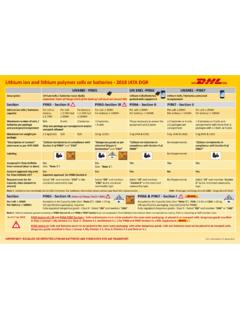Transcription of Introduction to German Construction Law
1 Introduction to German Construction Law by natalie Keller, Partner HFK Rechtsanw lte, Heiermann Franke Knipp, Germany* German Construction law comprises two basic fields - public Construction law and private Construction law. Public procurement law is also relevant. As a specialized firm for Construction related and real estate matters, HFK Rechtsanw lte covers the entirety of the aforementioned fields with a focus on private Construction law, public procurement and real estate Public Construction Law Public Construction law concerns all public regulations on Construction and is divided into two fields - zoning law and building regulations. Zoning law regulates urban and regional planning, including infrastructure and industrial development.
2 Zoning law sets forth the procedures for governmental decision-making concerning public projects and the admissibility of private ones. The main source of public Construction law is the federally legislated Building Code. The law related to building regulations defines exactly how to build. It includes such regulations as the permissible eaves height, the minimum distance to a neighboring property, safety regulations regarding static, materials, constructive details and fire protection. Building regulations can even determine the design of a Construction project, which must comply with the characteristics of a given region. Each federal state has its own building law, but these laws are largely congruent.
3 In addition, there are regulations on conservation, energy saving etc., and specific regulations on the municipal level. Every building in Germany must comply with all public laws. A building permit is a compulsory requirement. Public Procurement Law In public procurements, the contracting authorities are bound to award contracts under certain rules. In short, procurement must be economical and fair. The current procurement rules are a combination of European directives and national rules. Public procurement law is primarily focused on public authorities and public corporations, but also covers certain enterprises related to public needs.
4 From certain threshold values onward, contracting authorities must comply with European and national tender regulations for all acquisitions. The current threshold value for public Construction is set at million, which triggers compulsory Europe-wide contract notice requirements and application of certain procedural rules. For acquisitions that remain under the threshold value, specific national and regional procurement regulations must be observed. While every step made by contracting authorities is strictly regulated, tenderers must also comply with a set of formal criteria. Tenders that failed to comply with these criteria by, for example, altering the provided tender documents or submitting incomplete or delayed ones are excluded from consideration.
5 The remaining tenders are evaluated according to a catalogue of criteria, which must be included in the invitation to bid documents. All procurements are conducted under the same principles of equal treatment, transparency, competition, proportionality and promotion of SME companies. Tenderers have to prove their skills, efficiency, experience and reliability. Tenderers can take legal action at the bodies responsible for appeals (chambers) in the event they wish to challenge the procurement procedure or to assert defects in the invitation documents or competing tenders. If successful, the procurement procedure must be repeated and/or the tenderer can claim compensation.
6 Private Construction Law On the private side, German Construction contracts are surprisingly short. This is because the German Civil Code as well as the VOB/B-terms and conditions provide a substantial basis for most aspects of any contract. The prototype for Construction contracts is found in the Civil Code, usually translated as contract for work and services (Werkvertrag). Under this type of contract, as distinguished from a contract for services, it is the finished product, and not the work itself, for which payment is made. Consequently, the contractor is largely free to organize and carryout the work in the manner it sees fit. Only the date of acceptance is decisive.
7 Another basic rule is first work, then pay - softened by the right of the contractor to demand on-account payments and surety bonds. Further, the ordering party is free to terminate the contract at any time. Without a genuine reason for the termination, however, the ordering party is still obliged to pay the full price, less spared expenses basically resulting in recovery of the full profit margin by the contractor. With respect to defects, the contractor must be granted an adequate chance to perform remedial work before the ordering party can replace the contractor and claim related costs. All the basic rules discussed above come into effect automatically under the Civil Code and, therefore, apply to every Construction contract.
8 As a result, Construction contracts theoretically require only two additional terms: specification of the required work and the price. In fact, many private Construction contracts are concluded on the basis of the Civil Code with relatively little other verbage. In the commercial sector, virtually every Construction contract uses a set of standardized contract terms for Construction contracts known as the VOB/B. For contracting public authorities, use of the VOB, is mandatory. The VOB/B is one of three parts of the VOB, an abbreviation standing for procurement- and contract regulations for Construction work. VOB/A deals with procurement rules, VOB/B provides standardized contract rules, and VOB/C states particular technical regulations.
9 Under the VOB/B, a contract can also be concluded by merely specifying the work to be performed and the price. The basic Construction terms set forth in the VOB/B are consistent with the Civil Code and also certain more specific provisions. Among those more specific terms in the VOB/B are those concerning change orders and payment for extra work. The builder is free to make changes in the work at any time, but is required to pay any related costs. Also, the builder can demand the completion of extra work, provided that it stands in close relation to the original specifications (otherwise it is subject to a possible separate agreement. The parties should, but quite often do not, come to an agreement on the payment for extra work).
10 The VOB/B provides that the new price for addendum work must correlate with the so- called original calculation, , the contractor s pricing as set forth in the contract. In other words, the contractor is bound to his own calculation of costs throughout the whole project. If the parties do not agree on a price, it can be determined through judicial review. Factors like market-price increases are considered relevant. In fact, the new price must take into account all factors that were not foreseeable at the time the original agreement was executed. Such additional costs are paid by the builder. On the other hand, the contractor is bound to his profit margin and his original calculation of indirect expenses, including overhead costs, etc.







